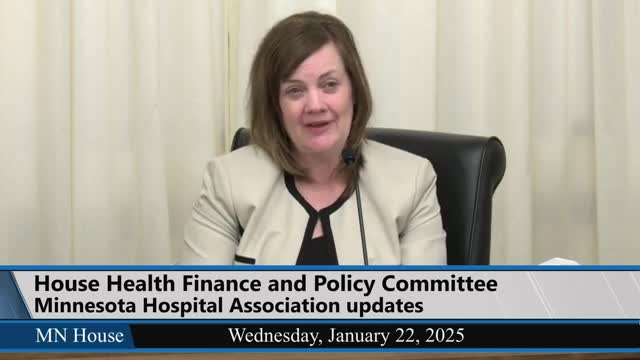Nursing home closures strain patient placements and increase hospital wait times in Minnesota
January 22, 2025 | 2025 Legislature MN, Minnesota
This article was created by AI summarizing key points discussed. AI makes mistakes, so for full details and context, please refer to the video of the full meeting. Please report any errors so we can fix them. Report an error »

During a recent meeting of the House Health Finance and Policy Committee in Minnesota, significant concerns were raised regarding the impact of nursing home closures on patient care and hospital operations. The discussions highlighted the challenges faced by healthcare facilities, particularly in light of workforce shortages and the increasing demand for patient placements.
One of the key issues addressed was the closure of a local nursing home, which has exacerbated the already strained healthcare system. Representatives noted that the closure was influenced by longer wait times for patient assessments and a lack of licensed practical nurses and nursing assistants. This workforce shortage has led to a reliance on temporary staff, which ultimately contributed to the nursing home's financial difficulties and its decision to shut down.
In response to the closure, the community's remaining nursing home, operated by the Benedictine Health System, has been working to accommodate displaced residents. However, the situation has become more complicated as additional nursing homes in the region have also closed, leading to a tighter market for available beds. The critical access hospital in the area reported a significant increase in the use of swing beds—non-acute hospital beds used for patients awaiting nursing home placements. Prior to the pandemic, the hospital averaged less than one swing bed patient per day; this number has now risen to four or five patients consistently.
The committee also discussed the broader implications of these closures, particularly regarding mental health patients who often face delays in receiving appropriate care. It was noted that many mental health patients are held in emergency rooms for extended periods while awaiting placement, further straining hospital resources. A study conducted by the hospital association revealed that approximately 2,000 patients were waiting for discharge across Minnesota hospitals, with the financial burden of uncompensated care reaching nearly half a billion dollars annually.
The discussions underscored the urgent need for solutions to address workforce shortages and improve patient placement processes in Minnesota's healthcare system. As the committee continues to explore these issues, the community remains concerned about the future of patient care and the sustainability of local healthcare facilities.
One of the key issues addressed was the closure of a local nursing home, which has exacerbated the already strained healthcare system. Representatives noted that the closure was influenced by longer wait times for patient assessments and a lack of licensed practical nurses and nursing assistants. This workforce shortage has led to a reliance on temporary staff, which ultimately contributed to the nursing home's financial difficulties and its decision to shut down.
In response to the closure, the community's remaining nursing home, operated by the Benedictine Health System, has been working to accommodate displaced residents. However, the situation has become more complicated as additional nursing homes in the region have also closed, leading to a tighter market for available beds. The critical access hospital in the area reported a significant increase in the use of swing beds—non-acute hospital beds used for patients awaiting nursing home placements. Prior to the pandemic, the hospital averaged less than one swing bed patient per day; this number has now risen to four or five patients consistently.
The committee also discussed the broader implications of these closures, particularly regarding mental health patients who often face delays in receiving appropriate care. It was noted that many mental health patients are held in emergency rooms for extended periods while awaiting placement, further straining hospital resources. A study conducted by the hospital association revealed that approximately 2,000 patients were waiting for discharge across Minnesota hospitals, with the financial burden of uncompensated care reaching nearly half a billion dollars annually.
The discussions underscored the urgent need for solutions to address workforce shortages and improve patient placement processes in Minnesota's healthcare system. As the committee continues to explore these issues, the community remains concerned about the future of patient care and the sustainability of local healthcare facilities.
View full meeting
This article is based on a recent meeting—watch the full video and explore the complete transcript for deeper insights into the discussion.
View full meeting
